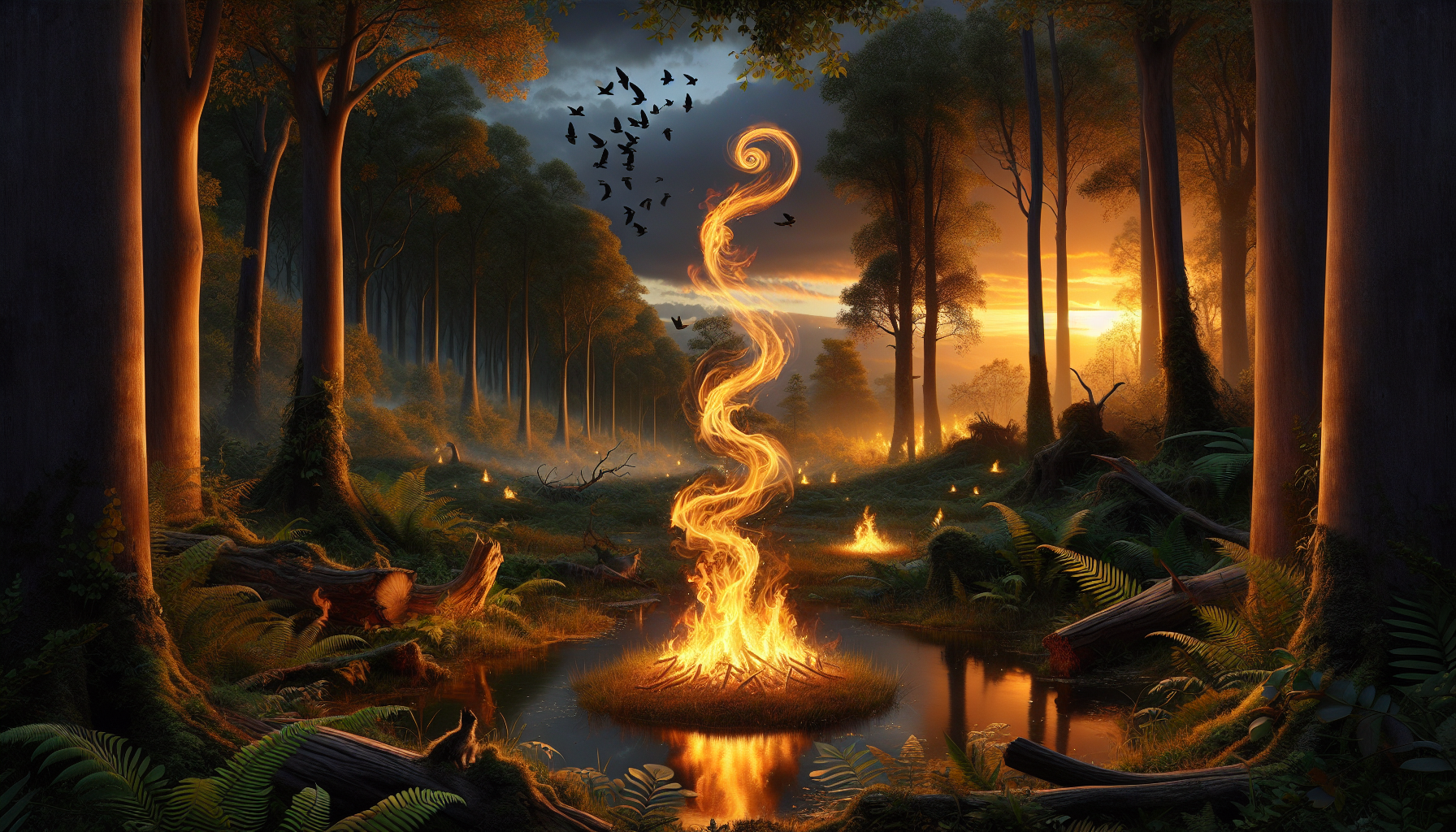In the quiet embrace of a forest at dawn, as the first rays of sunlight pierce through the dense canopy, there’s an ancient ritual taking place—a language spoken not with words, but with the crackling dance of flames. Fire, one of the most primal and powerful elements known to humankind, has been both a tool and a symbol throughout history. It is a force of nature that cleanses, transforms, and communicates in ways that are deeply woven into the fabric of our existence. 🔥 This blog post invites you to discover the power of fire as both a cleanser and a messenger, exploring its profound significance in the natural world and human culture.
At first glance, fire may seem like a destructive force, reducing everything in its path to ashes. However, when observed more closely, fire reveals its dual nature—a paradox of destruction and creation. The regenerative power of fire is evident in ecosystems around the world. Forest fires, often seen as catastrophic, are, in fact, a vital part of ecological cycles. They clear away dead and decaying matter, making way for new growth. In this natural rebirth, fire not only rejuvenates landscapes but also maintains the health and diversity of entire ecosystems. Throughout this article, we will delve into fascinating case studies of how various environments depend on fire to thrive and how certain species have adapted to this fiery phenomenon.
Beyond its ecological impact, fire has been a pivotal element in human evolution and culture. From the dawn of civilization, when our ancestors first harnessed its power, fire has been a source of warmth, protection, and sustenance. It has fueled technological advances and has been central to cultural rituals and storytelling. Firelight has long been a gathering point, a place where stories are told, and traditions are passed down through generations. In our exploration, we will uncover how different cultures interpret fire’s role in their myths and legends, and how this elemental force continues to inspire and influence art, religion, and science.
Finally, we will reflect on the symbolic and communicative power of fire. Its presence often marks significant transitions, symbolizing purification, transformation, and enlightenment. Whether it is the ceremonial flames of an Olympic torch or the comforting glow of a campfire, fire speaks a universal language of connection and change. As we journey through its history and significance, we will learn how to harness the transformative energy of fire in our own lives, using it as a metaphor for personal growth and renewal. This exploration will reveal that, much like fire itself, our lives are a delicate balance of destruction and creation, leading us to emerge stronger and more resilient from the ashes of our own challenges. 🌟
The Ancient Power of Fire in Nature
Fire has been a pivotal element in the evolution of ecosystems, human societies, and cultural practices. Its role as a force of destruction and renewal underscores its dual nature. Understanding fire’s intrinsic power requires delving into its historical significance, ecological benefits, and symbolic meanings in various cultures.
Throughout history, fire has been both revered and feared. Its ability to transform landscapes, shape environments, and influence human development is unparalleled. For early humans, mastering fire marked a turning point, providing warmth, protection, and a means to cook food. As societies evolved, so did the uses and interpretations of fire. In many ancient cultures, it was seen as a divine gift, a representation of the gods’ wrath or favor. Myths and legends often depict fire as a purifying force, capable of renewing life and spirit.
The ecological impact of fire is profound. In many ecosystems, fire acts as a natural regulator, maintaining biodiversity by clearing dead vegetation and promoting new growth. Certain species have adapted to rely on periodic fires for their life cycles, such as the lodgepole pine, which requires heat to release its seeds. In this way, fire acts as a natural gardener, ensuring the health and vitality of ecosystems. However, the balance is delicate, and human intervention often disrupts this natural process, leading to more intense and uncontrollable wildfires.
Fire as a Communication Tool in Nature
In the natural world, fire communicates changes and facilitates adaptations. The scent of smoke alerts animals to potential danger, while the aftermath of a fire creates opportunities for new life. This cycle of destruction and renewal is essential for maintaining the equilibrium within ecosystems. Furthermore, fire’s role in shaping landscapes influences the behavior and distribution of species, creating niches that support diverse life forms.
Humans have also used fire as a means of communication. Smoke signals, for example, were an effective way for indigenous peoples to convey messages across vast distances. The patterns and intensity of the smoke could be tailored to relay specific information, demonstrating the adaptability and ingenuity of early cultures in harnessing fire’s communicative power. Today, while technology has largely replaced fire for direct communication, its symbolic language endures in rituals and ceremonies around the world.
Ecological Benefits of Fire
The ecological benefits of fire are often overshadowed by its destructive potential. Yet, fire is integral to many natural processes, contributing to the health and sustainability of ecosystems. By clearing out dead and decaying matter, fire opens up space for new plants to grow, which in turn supports a diverse array of wildlife. This process of renewal is crucial in preventing the overaccumulation of biomass, which can lead to more severe fires if left unchecked.
| Ecological Benefits | Description |
|---|---|
| Nutrient Cycling | Releases nutrients back into the soil, promoting plant growth. |
| Promotes Biodiversity | Clears out old vegetation, creating space for diverse plant and animal life. |
| Seed Germination | Heat from fire triggers the germination of certain fire-adapted plant species. |
Adaptations to Fire
Many plant and animal species have evolved unique adaptations to survive and thrive in fire-prone environments. For instance, some trees have thick bark that protects their inner layers from heat damage. Other plants have developed fire-resistant seeds or roots that allow them to regenerate quickly after a fire. These adaptations not only ensure the survival of individual species but also contribute to the resilience of entire ecosystems.
Animals, too, have adapted behaviors to cope with the presence of fire. Some species, like the red-cockaded woodpecker, nest in fire-maintained pine forests, relying on the open habitat created by periodic burns. Others, such as certain reptiles and insects, take advantage of the post-fire environment to hunt or lay eggs. These interactions highlight the complex relationships between fire, flora, and fauna, underscoring the importance of fire in ecological balance.
Fire in Cultural Practices and Beliefs
The symbolic power of fire extends beyond its physical presence, permeating cultural practices and beliefs worldwide. In many traditions, fire is associated with purification and transformation. Rituals involving fire often symbolize a cleansing of the soul, a renewal of spirit, or a connection with the divine. For example, in Hinduism, fire ceremonies known as “homas” are performed to invoke blessings and purify the environment.
Fire’s role in cultural ceremonies is not limited to religious practices. Throughout history, communities have used fire as a focal point for social gatherings, storytelling, and celebrations. The communal aspect of fire, where individuals gather around its warmth and light, fosters a sense of unity and shared experience. This enduring relationship with fire reflects its multifaceted significance in human culture, from its practical uses to its profound symbolic meanings.
Modern Interpretations of Fire
In contemporary society, fire’s symbolic and practical roles continue to evolve. While its destructive power is often highlighted in the context of wildfires and climate change, there is a growing recognition of its ecological and cultural importance. Fire management practices increasingly emphasize the need to balance fire suppression with controlled burns, acknowledging the role of fire in maintaining healthy ecosystems.
At the same time, fire remains a potent symbol in art, literature, and popular culture. It represents both creation and destruction, passion and anger, life and death. These dualities mirror the complex nature of fire itself, a force that both nurtures and challenges. As we continue to explore and understand fire’s place in the world, it remains an enduring testament to nature’s ancient language and the human spirit’s resilience.

Conclusion
In conclusion, the exploration of fire as both a cleansing force and a means of communication in nature’s ancient language has provided us with profound insights into its multifaceted roles in our world. Throughout this article, we have delved into the historical significance of fire, its ecological impact, and its symbolic power, offering a comprehensive understanding of its place in human culture and natural ecosystems.
Initially, we explored the historical context of fire, highlighting how it has been an essential tool for human survival and development. From the earliest days of humanity, fire has served as a source of warmth, a method for cooking, and a protective barrier against predators. These practical uses have been complemented by its cultural significance, as fire ceremonies and rituals have been pivotal in community bonding and spiritual practices across various civilizations. This duality of fire as both a physical and metaphysical entity underscores its indispensable role in shaping human societies.
Furthermore, we examined the ecological aspect of fire, particularly its role in natural processes like forest regeneration and habitat maintenance. Fire can act as a natural cleanser, removing dead and decaying matter, thus facilitating new growth and maintaining ecological balance. This regenerative capacity of fire underscores its importance in maintaining biodiversity and fostering resilient ecosystems. Controlled burns and fire management practices, when applied thoughtfully, can mimic these natural processes to prevent catastrophic wildfires and promote healthy landscapes.
Moreover, the article highlighted the symbolic power of fire as a universal language of transformation and communication. Fire’s dynamic and transformative nature serves as a metaphor for change, renewal, and the continuous cycle of life and death. In many cultures, fire is seen as a purifying element, capable of cleansing impurities and symbolizing rebirth. This symbolic interpretation of fire enriches our understanding of its role in both personal growth and communal identity, offering a shared language that transcends cultural boundaries.
The importance of understanding and harnessing the power of fire cannot be overstated. In the context of climate change and increasing wildfire incidents, it is crucial to adopt sustainable fire management practices that respect both human needs and ecological integrity. By learning from indigenous practices and integrating scientific research, we can develop strategies that leverage fire’s benefits while mitigating its potential dangers.
As we conclude, it is imperative to recognize the enduring relevance of fire in our modern world. Whether through its practical applications, ecological functions, or symbolic meanings, fire continues to be a catalyst for innovation, adaptation, and connection. We encourage you, the reader, to reflect on the insights gained from this exploration of fire’s power and consider how you might apply these lessons in your own life and community.
Share this article with others who may find value in understanding the complexities and beauties of fire. Engage in discussions about fire management and ecological preservation, and consider participating in community efforts aimed at fostering a harmonious relationship with this elemental force. 🌱🔥
For further reading and resources, consider exploring the following active links: , , and . These sources offer a wealth of information for those interested in delving deeper into the subject.
In closing, let fire be a reminder of both our primal origins and our capacity for growth and renewal. Embrace its lessons, share its stories, and continue to discover the transformative power of fire in your journey. 🔥✨
Toni Santos is a visual storyteller and symbolic naturalist whose creations explore the hidden ecologies and forgotten bonds between humans and nature, as whispered through ancient lore. Through an intuitive and myth-sensitive lens, Toni reveals the sacred choreography between flora, fauna, and human spirit — a world where trees once spoke, rivers remembered, and every herb carried a secret name.
His journey is rooted in the esoteric — in the rituals of forest-dwellers, the botanical codes of shamans, and the unspoken pacts that shaped how ancient peoples lived in deep, reciprocal harmony with the natural world. From sacred groves to serpent-guarded springs, each of Toni’s works reflects a symbolic relationship long obscured by modern forgetfulness.
With a background in visual design and ancestral aesthetics, Toni merges storytelling with sacred ecology. His pieces don’t simply illustrate — they channel. Drawing from myth, mysticism, and lost herbal traditions, he crafts visuals that resonate with the old wisdom: that nature is not background, but kin.
As the creative spirit behind Vizovex, Toni shares collections, visual studies, and articles that illuminate the occulted connections between human life and the wild world. His work calls on us to remember — not just with the mind, but with the senses and the soul — the profound dialogues our ancestors once had with earth, plant, and animal.
His work is a tribute to:
The mythic language of trees, stones, and roots
Forgotten pacts between healers and the wilderness
The sacred knowledge carried in nature’s unseen patterns
Whether you’re a seeker of ancient plant-lore, a mystic attuned to seasonal cycles, or simply someone who hears the forest speak, Toni welcomes you to wander a space where symbolism, nature, and spirit entwine — one myth, one leaf, one vision at a time.





